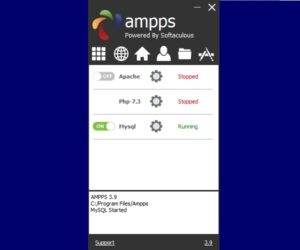

The most obvious characteristic of XAMPP is the ease at which a WAMP webserver stack can be deployed and instantiated.
AMPPS LINUX MINT FULL
XAMPP is offered in both a full and a standard version (Smaller version). Self-contained, multiple instances of XAMPP can exist on a single computer, and any given instance can be copied from one computer to another. It also comes with a number of other modules, including OpenSSL, phpMyAdmin, MediaWiki, Joomla, WordPress and more. XAMPP is regularly updated to the latest releases of Apache, MariaDB, PHP and Perl. The Windows version of XAMPP requires Microsoft Visual C++ 2017 Redistributable. XAMPP requires only one zip, tar, 7z, or exe file to be downloaded and run, and little or no configuration of the various components that make up the web server is required. XAMPP formerly used MySQL, but this was replaced with MariaDB on 19 October 2015 and beginning with XAMPP versions 5.5.30 and 5.6.14, altering the meaning of the acronym. The Apache Friends website indicates that XAMPP stands for "XAMPP Apache + MariaDB + PHP + Perl", so that the abbreviation is a recursive acronym. XAMPP's ease of deployment means a WAMP or LAMP stack can be installed quickly and simply on an operating system by a developer, with the advantage that common add-in applications such as WordPress and Joomla! can also be installed with similar ease using Bitnami. Since most actual web server deployments use the same components as XAMPP, it makes transitioning from a local test server to a live server possible. æ m p/) is a free and open-source cross-platform web server solution stack package developed by Apache Friends, consisting mainly of the Apache HTTP Server, MariaDB database, and interpreters for scripts written in the PHP and Perl programming languages. English, German, French, Dutch, Polish, Italian, Norwegian, Spanish, Chinese, Brazilian Portuguese, Japanese


 0 kommentar(er)
0 kommentar(er)
